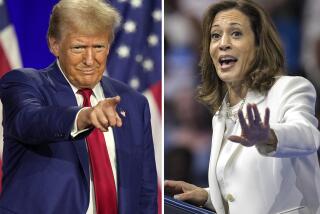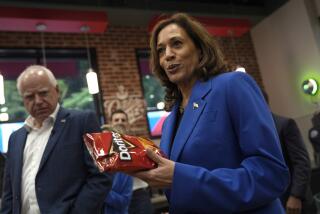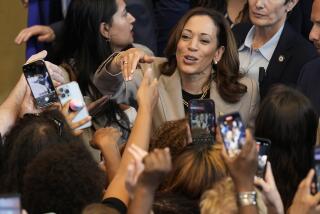Moynihan Shoots for Huge Hike in Ammunition Tax : Congress: Influential senator says he will insist on quadrupling levy to help pay for health care reform. Plan draws fire from the NRA.
- Share via
WASHINGTON — The chairman of the Senate Finance Committee said Wednesday that he will insist on quadrupling the federal tax on most handgun ammunition in order to help pay for health care reform and stem a national tide of violence--a move that draws the politically powerful gun lobby into the already complex health care debate.
“There’s a lot of ammunition out there that has the sole purpose of destroying bodies and you could tax it out of existence,” said Sen. Daniel Patrick Moynihan (D-N.Y.), whose control of the finance panel gives him considerable influence over health care legislation.
Although Moynihan conceded that his idea has sparked little enthusiasm from the White House, he said he feels “very strongly” about the tax and “can’t imagine” his panel passing a health care bill without it. It is the first time Moynihan has made a specific demand about the contents of the health care package.
Treasury Secretary Lloyd Bentsen, a former Finance Committee chairman, said in testimony before the panel Wednesday that he is “quite willing to look at that as an addition” to the health care plan, but he noted that it would not be a big source of revenue.
Moynihan introduced his proposal as separate legislation but said he plans to incorporate it into the health care bill.
It would raise an estimated $200 million a year by increasing the current 11% federal tax on ammunition to 50% on most types of handgun bullets, excluding .22-caliber rim fire ammunition commonly used in target shooting.
Additionally, a 10,000% levy would be imposed on two particularly lethal types of ammunition: .50-caliber bullets and the Winchester 9-millimeter “Black Talon.”
Advertisements for the Black Talon boast that it “penetrates soft tissue like a throwing star--very nasty, very effective, a real improvement in handgun ammo.”
The legislation would also levy a $10,000-a-year occupational tax on manufacturers and importers of handgun ammunition, exempting those who do business exclusively with police and other government agencies.
Describing his approach in his characteristically professorial way, Moynihan said he was taking an epidemiologist’s view of “the most urgent health emergency in our country. . . . Guns don’t kill people and bullets do.” He noted that handgun ammunition kills more than 24,000 Americans each year and accounts for two-thirds of firearm-related deaths.
Moynihan’s proposal drew immediate criticism from the politically powerful National Rifle Assn., which said the legislation would penalize hunters, competitive shooters and people who keep guns for self-defense.
“It’s laughable. It really is,” NRA Executive Vice President Wayne La Pierre said. “I seriously doubt anybody in America believes a tax is going to stop violent crimes. . . . It shows how eggheaded this whole debate has become.”
Moynihan made his proposal as the debate over health care continued to heat up. On Wednesday, President Clinton and the health insurance industry’s main trade association traded another round of attacks.
Addressing a crowd at an Ambridge, Pa., high school, Clinton noted that First Lady Hillary Rodham Clinton this week had “a little argument” with the Health Insurance Assn. of America over its television advertising campaign. She had called the group’s ads lies, and declared that the insurance business had driven the health care system to the brink of bankruptcy.
Clinton suggested that the industry’s opposition to reform stems from a desire to protect its profits, and later added: “There’s a lot of money in this health care system that doesn’t have a thing to do with health care.”
The Ambridge crowd was unusually well-suited for the Clintons’ appeal because the area has lost 155,000 jobs in recent years.
Many residents remain unemployed, and others took early retirement from manufacturing concerns and later learned that the health care benefits they had counted on were being cut back.
Pennsylvania also became the first battleground of the health care reform movement two years ago, when Democratic Sen. Harris Wofford won his seat by campaigning on the issue. Seated next to Wofford on the dais, Clinton took note of the occasion, saying that Pennsylvanians “fired a shot heard around America.”
Back in Washington, the HIAA announced plans to launch another in its series of TV advertisements attacking Clinton’s plan. By Thanksgiving, the industry will have spent some $6.5 million on its current round of advertising, association officials said.
“Our views are not unique,” said HIAA President Bill Gradison, a former GOP congressman from Ohio. “But we’re the only ones getting beat up.”
The fight between the Administration and the health insurers’ group, which mainly represents medium- and smaller-sized companies in the industry, revolves primarily around three issues: Clinton’s plans to put a cap on insurance premiums as a way of controlling overall health care costs, his proposal to funnel most insurance through huge regional “health alliances” and his plan to require insurers to offer coverage to all residents of a given area at the same basic “community rate.”
The Administration hopes that limiting insurance premiums will force insurers to squeeze costs out of the rest of the system--providing cost control without intensive, direct government regulation. But Gradison argued that the caps threaten the financial viability of the insurance industry.
“It will be impossible” for insurers to cover all Americans if they cannot raise the capital they need to invest, he said.
Times staff writer David Lauter contributed to this story.
More to Read
Get the L.A. Times Politics newsletter
Deeply reported insights into legislation, politics and policy from Sacramento, Washington and beyond. In your inbox twice per week.
You may occasionally receive promotional content from the Los Angeles Times.











